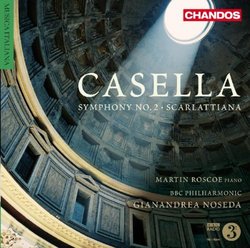Two Impressive Early 20th-Century Italian Orchestral Works
J Scott Morrison | Middlebury VT, USA | 07/24/2010
(5 out of 5 stars)
"Alfredo Casella (1883-1947) was an unusual figure among Italian composers of the early twentieth century in that like his friend Giuseppe Martucci he did not write operas. Rather he focused primarily on orchestral, chamber and piano works. Although born in Turin to a family of musicians, he was sent to France to study under Gabriel Fauré. He remained in France for nineteen years before returning to Italy. His music, though displaying the orchestrational skills of early twentieth century French composers, does not sound particularly French; the composer himself felt his musical style, to the degree it could be characterized by nationality, was 'European'. This disc contains his Second Symphony, which had never been recorded before, and his much-recorded Scarlattiana, a light-hearted piece using some of Scarlatti's piano sonatas as basis and featuring a concertante piano part.
In one of those strange coincidences that sometimes occurs in classical music recordings, slightly later in the same month that this CD was issued another recording of the Symphony No. 2 became available on the Naxos label Casella: Symphony No. 2 - A notte alta for Piano and Orchestra; I have not heard that performance. The Second Symphony is a large piece taking almost 50 minutes to perform. It is in five movements. Written in 1908-1910 it was influenced heavily by Caslla's infatuation with and close study of Mahler's symphonies. He had arranged for the first ever performance in France of a Mahler symphony (the 'Resurrection' Symphony) and just two weeks later his own Second Symphony had its own première. Although his music really doesn't sound at all like Mahler, it has some of Mahler's characteristics in that although it is formally coherent there are frequent changes of tempo or mood. In the first movement alone there are seventeen changes of tempo or mood (e.g. Lento, grave, solenne - Allegro moderato assai - Lento - Allegro energico - Animando - Con tutti forza, etc. etc.). The first movement is a huge, granitic mood piece that is followed by a sort of scherzo which starts out as a tarantella but quickly shows a darker mood. III, an Adagio, is basically lyrical but becomes more and more agitated as it goes along. IV is the most obviously Mahlerian movement as it is an alternately satiric or doleful march. V, labeled Epilogo, is a six-minute summing up that starts with an impressionistically ethereal mood which lightens to a repeat, in major key, of the Adagio's main theme and then closing with a reminiscence of the work's opening Lento theme.
Completely in contrast to the Symphony is the altogether lighter five-movement 'Scarlattiana', written in 1926. It is reminiscent of other roughly contemporaneous works based on earlier Italian masters like Stravinsky's 'Pulcinella' (based on melodies attributed to Pergolesi) and Respighi's 'La Boutique fantasque' (based on Rossini). Casella uses literally dozens of melodies from the more than five hundred piano sonatas ('Essercizi') Scarlatti wrote. If nothing else one realizes anew what a marvelous melodist Scarlatti was. Some of the finer points in this composition are Casella's use of slow introductions to some of the livelier sections, the use of castanets in the 'Capriccio', reminding us of Scarlatti's long residence in Spain, some exciting metrical irregularities that could only have been written in the twentieth century, along with some daring (for Scarlatti, at least) harmonic twists. The very important concertante piano part is here played expertly and wittily by one of England's finest pianists, Martin Roscoe. Gianandrea Noseda conducts the fine BBC Philharmonic. They had earlier recorded Casella's First Symphony, also on Chandos Alfredo Casella: Sinfonia per Orchestra, Op. 63; Italia, Op. 11.
This is an intriguing disc for those who have, for instance, been pleased with the other recent CDs of instrumental music from Italy (Martucci, Respighi, Malipiero) from early in the last century.
Scott Morrison
"


 Track Listings (10) - Disc #1
Track Listings (10) - Disc #1